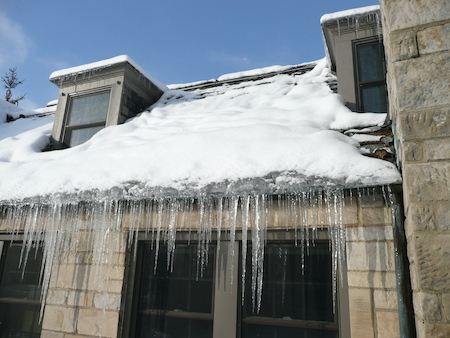
As seasoned New Englanders we know how harsh winter weather can be. But we are well equipped to deal with the ice, snow and cold because we go through it every year.
But while shoveling, snow blowing, and removing ice from the windshield may be second nature to you, preventing ice dams may have you scratching your head.
Ice dams are essentially big blocks or thick sheets of ice hanging over your home’s eaves. They form due to a vicious cycle of snow melting, running down the roof, then re-freezing at the edges where it’s not as warm. While unsightly and dangerous to passersby below, they can also cause serious structural damage by allowing water to back up into your home.
Ice dams are a sign of insufficient attic venting and insulation. During the warmest parts of the day, the ice melts and pools behind the top layer of ice, seeping under the shingles and dripping through the roof into the soffits, ceilings and walls. The aftermath can take the form of rust spots on drywall fasteners, peeling paint, sagging drywall and staining around doors and windows. These fixes aren’t cheap.
Ice dams form when your roof is warmer than 32 degrees F, which — while warm enough to melt the snow – isn’t enough to melt the edges. Thus, those portions stay frozen. Why does this happen? Essentially, the attic is too warm.
Tips to Prevent Ice Dams
There are things you can do as a homeowner to prevent ice dams from occurring in the first place. Follow these proven tips.
Add more insulation: Take this time to measure how deep your attic insulation is. It’s ideal to have between 12 and 14 inches of fiberglass or cellulose insulation. If you need to, add more insulation. Blown-in cellulose and fiberglass are good choices and are probably better than rolls because they conform to every little gap.
Add more venting: Your attic ventilation draws in cold air and sends out warmer air during the winter, naturally keeping your attic cool. This is crucial to prevent ice dams. But to get more ventilation than that, add roof and soffit vents.
Close up attic bypasses: With one-third of heat loss occurring through the ceiling and into the attic, it’s important to close any bypasses you may detect. Leaks happen with unblocked walls, drywall gaps, and cracks around light fixtures, chimneys, pipes, and access hatches. To plug up these air leaks, go into the attic, peel back the insulation, and fill the gaps with foam or caulk. This may be pretty tough to do — even downright impossible and dangerous – if you don’t know what you’re doing. Always call an insulation expert or roofer in Methuen MA for this job.
Contact Hi-Tech Windows & Siding for Roofing Maintenanc
If you experience frequent ice dams in winter, call Hi-Tech Windows & Siding today at 800-851-0900 to schedule a roof inspection. Our roofers can provide helpful advice on how you can prevent ice dams from forming. Plus, we can perform all work safely and efficiently before the frigid temps of winter set in.
- Category: Home Improvement, Roofing Contractor
- 0 comment
